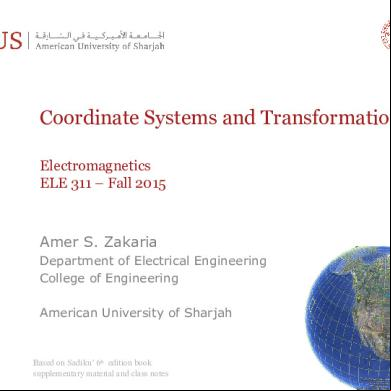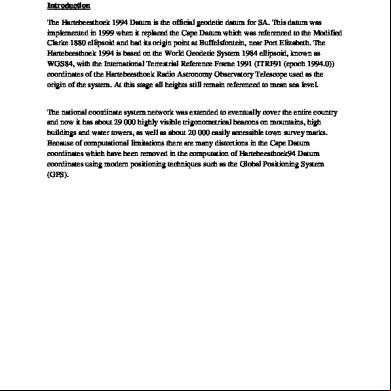2 - Coordinate Systems And Transformation 1x6et
This document was ed by and they confirmed that they have the permission to share it. If you are author or own the copyright of this book, please report to us by using this report form. Report l4457
Overview 6h3y3j
& View 2 - Coordinate Systems And Transformation as PDF for free.
More details h6z72
- Words: 930
- Pages: 30
Coordinate Systems and Transformation Electromagnetics ELE 311 – Fall 2015
Amer S. Zakaria Department of Electrical Engineering College of Engineering American University of Sharjah
Based on Sadiku’ 6th edition book supplementary material and class notes
Learning Objectives Understand the differences between three coordinate systems: Cartesian, Cylindrical, and Spherical. Represent vectors in any of the three coordinate systems. Transform points or vectors in space from one coordinate system to the other.
Electromagnetics | Coordinate Systems and Transformation
Coordinate Systems
Coordinate Systems (1/2) There are various ways to describe to location of a point in space. In geometry, a coordinate system is one way that uses one or more numbers to uniquely specify that location. Here, we are interested in three-dimensional orthogonal coordinate systems: • Three-dimensional: Three surfaces intersect at the point location. • Orthogonal: The surfaces are mutually perpendicular to each other. Electromagnetics | Coordinate Systems
Coordinate Systems (2/2) In this course we are interested in three coordinate systems: Cartesian (Rectangular) Coordinates Cylindrical (Circular) Coordinates Spherical Coordinates The choice of the coordinate system is based on the problem at hand. Regardless, the solution at the end is always the same; after doing the proper coordinate transformation of course! Electromagnetics | Coordinate Systems
Cartesian Coordinate System
René Descartes 1596 - 1650
Cartesian Coordinate System It consists of three perpendicular constant planes.
x-plane
y-plane
z-plane
Each plane defined by a unit vector ⊥to it. Electromagnetics | Cartesian Coordinate System
Cartesian Coordinate System (cont.) How a point is formed?
Two planes intersect to form a line
Line and third plane intersect to form a point.
A point uniquely defined by location of 3-planes: P(x, y, z). Similarly a vector is defined using components in each plane and the corresponding unit vector: Electromagnetics | Cartesian Coordinate System
Differentials Elements To perform integration and differentiation of vectors, differential elements should be defined in
Length
Area
Which one to use? • Depends on the problem at hand. Differential elements’ definitions depend on coordinate system used. Electromagnetics | Cartesian Coordinate System
Volume
Differentials – Cartesian Coordinate System Differential Length (or displacement) Differential Area
Differential Volume
Electromagnetics | Cartesian Coordinate System
Cylindrical Coordinate System
Cylindrical Coordinate System It consists of three perpendicular constant planes.
A cylindrical surface with radius ρ
Half –plane with angle φ from x-axis
z-plane
Each plane defined by a unit vector ⊥to it. Electromagnetics | Cylindrical Coordinate System
Cylindrical Coordinate System (cont.)
Electromagnetics | Cylindrical Coordinate System
Cylindrical Coordinate System (cont.) How a point is formed?
Two planes intersect to form a line
Line and third plane intersect to form a point.
A point uniquely defined by location of 3-planes: P(ρ, φ, z). Similarly a vector is defined using components in each plane and the corresponding unit vector: Electromagnetics | Cylindrical Coordinate System
Differentials – Cylindrical Coordinate System Differential Length (or displacement) Differential Area
Differential Volume
Electromagnetics | Cylindrical Coordinate System
Point Location Transformations Cartesian Cylindrical
Cylindrical Cartesian
Electromagnetics | Cylindrical Coordinate System
Unit Vector Transformations
Cylindrical Components of
Electromagnetics | Cylindrical Coordinate System
Cylindrical Components of
Vector Transformation Matrices Cartesian Cylindrical
Cylindrical Cartesian
Electromagnetics | Cylindrical Coordinate System
Spherical Coordinate System
Spherical Coordinate System It consists of three perpendicular constant planes.
A spherical plane with radius r
Conical Surface with cone angle θ with z-axis
Half –plane with angle φ from x-axis
Each plane defined by a unit vector ⊥to it. Electromagnetics | Spherical Coordinate System
Spherical Coordinate System (cont.)
Electromagnetics | Spherical Coordinate System
Spherical Coordinate System (cont.) How a point is formed?
Two planes intersect to form a line
Line and third plane intersect to form a point.
A point uniquely defined by location of 3-planes: P(r, θ, φ). Similarly a vector is defined using components in each plane and the corresponding unit vector: Electromagnetics | Spherical Coordinate System
Differentials – Spherical Coordinate System Differential Length (or displacement) Differential Area
Differential Volume
Electromagnetics | Spherical Coordinate System
Point Location Transformations Cartesian Spherical
Spherical Cartesian
Electromagnetics | Spherical Coordinate System
Vector Transformation Matrices Cartesian Spherical
Spherical Cartesian
Electromagnetics | Spherical Coordinate System
Vector Algebra
Vector Algebra • Given two vectors and , in order to perform vector algebra operations like addition, dot product, cross product, etc.
They must be described in same coordinate system! If they are not presented in the same coordinate system, transform one vector to match the system of the other vector. In general, if
Electromagnetics | Vector Algebra
Constant-Coordinate Surfaces • Fixing one space variable in any of the coordinate systems, defines a surface. A unit normal vector to surface n = constant is . Examples: Unit vectors is normal to rectangular plane Unit vectors is normal to conical surface Unit vectors is normal to cylindrical surface . Intersecting two surfaces produces a line (RQ) normal to third surface. Intersecting the third surface defines a point (P).
Electromagnetics | Vector Algebra
Normal and Tangential Vectors • Given a vector , its normal component to a surface n is The normal component is perpendicular to surface n. The tangential component of to surface n is The tangential component is parallel to surface n. Tangential unit vector to surface n is
surface n in any coordinate system Electromagnetics | Vector Algebra
End of Coordinate Systems and Transformation
Amer S. Zakaria Department of Electrical Engineering College of Engineering American University of Sharjah
Based on Sadiku’ 6th edition book supplementary material and class notes
Learning Objectives Understand the differences between three coordinate systems: Cartesian, Cylindrical, and Spherical. Represent vectors in any of the three coordinate systems. Transform points or vectors in space from one coordinate system to the other.
Electromagnetics | Coordinate Systems and Transformation
Coordinate Systems
Coordinate Systems (1/2) There are various ways to describe to location of a point in space. In geometry, a coordinate system is one way that uses one or more numbers to uniquely specify that location. Here, we are interested in three-dimensional orthogonal coordinate systems: • Three-dimensional: Three surfaces intersect at the point location. • Orthogonal: The surfaces are mutually perpendicular to each other. Electromagnetics | Coordinate Systems
Coordinate Systems (2/2) In this course we are interested in three coordinate systems: Cartesian (Rectangular) Coordinates Cylindrical (Circular) Coordinates Spherical Coordinates The choice of the coordinate system is based on the problem at hand. Regardless, the solution at the end is always the same; after doing the proper coordinate transformation of course! Electromagnetics | Coordinate Systems
Cartesian Coordinate System
René Descartes 1596 - 1650
Cartesian Coordinate System It consists of three perpendicular constant planes.
x-plane
y-plane
z-plane
Each plane defined by a unit vector ⊥to it. Electromagnetics | Cartesian Coordinate System
Cartesian Coordinate System (cont.) How a point is formed?
Two planes intersect to form a line
Line and third plane intersect to form a point.
A point uniquely defined by location of 3-planes: P(x, y, z). Similarly a vector is defined using components in each plane and the corresponding unit vector: Electromagnetics | Cartesian Coordinate System
Differentials Elements To perform integration and differentiation of vectors, differential elements should be defined in
Length
Area
Which one to use? • Depends on the problem at hand. Differential elements’ definitions depend on coordinate system used. Electromagnetics | Cartesian Coordinate System
Volume
Differentials – Cartesian Coordinate System Differential Length (or displacement) Differential Area
Differential Volume
Electromagnetics | Cartesian Coordinate System
Cylindrical Coordinate System
Cylindrical Coordinate System It consists of three perpendicular constant planes.
A cylindrical surface with radius ρ
Half –plane with angle φ from x-axis
z-plane
Each plane defined by a unit vector ⊥to it. Electromagnetics | Cylindrical Coordinate System
Cylindrical Coordinate System (cont.)
Electromagnetics | Cylindrical Coordinate System
Cylindrical Coordinate System (cont.) How a point is formed?
Two planes intersect to form a line
Line and third plane intersect to form a point.
A point uniquely defined by location of 3-planes: P(ρ, φ, z). Similarly a vector is defined using components in each plane and the corresponding unit vector: Electromagnetics | Cylindrical Coordinate System
Differentials – Cylindrical Coordinate System Differential Length (or displacement) Differential Area
Differential Volume
Electromagnetics | Cylindrical Coordinate System
Point Location Transformations Cartesian Cylindrical
Cylindrical Cartesian
Electromagnetics | Cylindrical Coordinate System
Unit Vector Transformations
Cylindrical Components of
Electromagnetics | Cylindrical Coordinate System
Cylindrical Components of
Vector Transformation Matrices Cartesian Cylindrical
Cylindrical Cartesian
Electromagnetics | Cylindrical Coordinate System
Spherical Coordinate System
Spherical Coordinate System It consists of three perpendicular constant planes.
A spherical plane with radius r
Conical Surface with cone angle θ with z-axis
Half –plane with angle φ from x-axis
Each plane defined by a unit vector ⊥to it. Electromagnetics | Spherical Coordinate System
Spherical Coordinate System (cont.)
Electromagnetics | Spherical Coordinate System
Spherical Coordinate System (cont.) How a point is formed?
Two planes intersect to form a line
Line and third plane intersect to form a point.
A point uniquely defined by location of 3-planes: P(r, θ, φ). Similarly a vector is defined using components in each plane and the corresponding unit vector: Electromagnetics | Spherical Coordinate System
Differentials – Spherical Coordinate System Differential Length (or displacement) Differential Area
Differential Volume
Electromagnetics | Spherical Coordinate System
Point Location Transformations Cartesian Spherical
Spherical Cartesian
Electromagnetics | Spherical Coordinate System
Vector Transformation Matrices Cartesian Spherical
Spherical Cartesian
Electromagnetics | Spherical Coordinate System
Vector Algebra
Vector Algebra • Given two vectors and , in order to perform vector algebra operations like addition, dot product, cross product, etc.
They must be described in same coordinate system! If they are not presented in the same coordinate system, transform one vector to match the system of the other vector. In general, if
Electromagnetics | Vector Algebra
Constant-Coordinate Surfaces • Fixing one space variable in any of the coordinate systems, defines a surface. A unit normal vector to surface n = constant is . Examples: Unit vectors is normal to rectangular plane Unit vectors is normal to conical surface Unit vectors is normal to cylindrical surface . Intersecting two surfaces produces a line (RQ) normal to third surface. Intersecting the third surface defines a point (P).
Electromagnetics | Vector Algebra
Normal and Tangential Vectors • Given a vector , its normal component to a surface n is The normal component is perpendicular to surface n. The tangential component of to surface n is The tangential component is parallel to surface n. Tangential unit vector to surface n is
surface n in any coordinate system Electromagnetics | Vector Algebra
End of Coordinate Systems and Transformation










